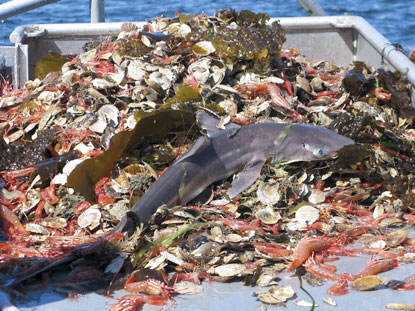[On January 24, 2017 Mayor Rahm Emanuel] announced that Chicago has reduced its carbon emissions by 7% from 2010 to 2015, according to a new analysis. This reduction in greenhouse gases came at the same time Chicago saw a 25,000 person increase in its population and 12 percent growth in the region’s economy and jobs within the city. The emissions reduction, equivalent to shutting down a coal power plant for 8 months, compares to a 1 percentage increase in nationwide emissions from 2009 to 2014.
...
The preliminary analysis, developed by AECOM, and the first 2015 emissions inventory for any major North America city, estimates Chicago generated 30.9 million metric tons of carbon dioxide equivalent in 2015, compared to 33.3 million in 2010. On a per capita basis emissions were reduced by 8%. The most significant reductions came from the energy used in buildings and construction. Together, the energy used to power residential, commercial, and institutional buildings comprises 73% of Chicago’s greenhouse gas emissions, and emissions from this sector have been reduced by 10%. Many of the decreases are due to lowered electricity consumption as well as switching to a less carbon-intensive fuel mix to power the electricity supply.
“Recent research by C40 shows that cities are at the center of the fight to reduce carbon emissions, and Chicago is no exception,” said Mark Watts, Executive Director of the C40 Cities Climate Leadership Group....
Over the past five years the Emanuel administration has taken significant steps to reduce energy use in buildings.
Retrofit Chicago
The Mayor’s Retrofit Chicago initiative, which facilitates energy efficiency improvements in municipal, commercial, nonprofit, and residential buildings, has retrofits planned, underway, or completed in over 23,000 homes and 132 large buildings collectively spanning over 75 million square feet. 11 new properties have joined the Retrofit Chicago Energy Challenge, in which buildings commit to a 20 percent energy reduction within five years. The new participants include six Chicago Housing Authority properties and a house of worship, reflecting the widening scope of the program. Additionally, 11 existing buildings recently received the Mayor’s Leadership Circle Award for meeting or exceeding the program’s 20 percent energy reduction target within 5 years.
Energy Benchmarking
The Chicago Energy Benchmarking ordinance accelerates energy efficiency by increasing awareness and transparency of energy use in large buildings. The City of Chicago’s
Benchmarking Report, also released on January 24, 2017, shows nearly 2,700 buildings reported energy use to City, with buildings located in every neighborhood. The Report indicates regular tracking and reporting is helping to reduce energy use. Properties that have reported three consecutive years have reduced energy use by 4%, and those that have reported for two consecutive years have reduced energy use by 2%.
Together, these properties have achieved estimated energy savings of $17.6 million per year.
Residential Disclosure
Chicago is the first and only jurisdiction to have energy use data into real estate listings (MLS) in the United States, allowing owners of low energy use homes to highlight the value of their energy efficiency upgrades. A 2014 study showed homes that disclosed their energy costs via the MLS sold for a greater percentage of the asking price and sold faster than those that did not.
Moving Away from Coal
In addition to working with community groups to close the Fisk and Crawford coal-fired power plants the City has utilized its buying power by removing coal from the power mix from the over $70 million of electricity its purchases annually to power public buildings, streetlights, and airports.
“The Chicago Housing Authority (CHA) provides homes to over 50,000 families and individuals, while supporting healthy communities in neighborhoods throughout the city,” said Ellen Sargent, the Director of Sustainable Initiatives at Chicago Housing Authority. “The CHA is also strongly committed to sustainable goals and objectives, such as water and energy-saving initiatives, as a way to improve our facilities and reduce costs. We are thrilled to join the Retrofit Chicago Energy Challenge as we continue on our path of tracking and reducing energy use at our facilities.”
“Improving energy efficiency throughout the Chicago Board of Trade Building™ is a key strategy of our management team,” according to Dennis Lambert, Vice President and General Manager of GlenStar Asset Management, LLC. “We are excited about the 20 percent commitment to energy reduction made by joining the Retrofit Chicago Energy Challenge, and look forward to serving as an energy ambassador to other properties looking to reduce energy consumption.”
AECOM will release its full report in 2017 that will provide information about comparisons between emissions for 2005, 2010, & 2015. The preliminary carbon reduction report can be found at:
www.CityofChicago.org/Emissions. The Energy Benchmarking Report can be found at:
www.CityofChicago.org/EnergyBenchmarking.
...
Wilbur Wright College recently completed several energy retroft projects including re-cladding the library, adding insulation, and upgrading lighting. From FY2014 to FY2016, the College achieved annual energy reductions of 17% of natural gas usage (57,000 therms) and 19% of electricity usage (1,300,000 kWh), saving approximately $78,000 per year in four buildings containing 544,380 square feet constructed circa 1993.
City of Chicago www.CityofChicago.org
Press Release dated January 24, 2017











